#queer fairytales
Text
One very interesting to note when comparing the "literary" fairytales and the "folkloric" fairytales - the fairytales actually rewritten or entirely written by authors for a literate public versus the oral folktales and "countryside" or "simple folks" fairytales collected by folklorists.
The latter tend to be very conservative, the former much more progressive than you think. Or rather... when you've got crazy nationalist and xenophobes and discriminators of all kinds, they'll turn towards the "folkloric" fairytales - but when you want to research queer, society-questioning, gender-norms-breaking, eerily modern fairytales, you'll go with the literary fairytales rather.
Don't get me wrong, do NOT get me wrong - both kind of fairytales are usually very racist in one way or another because they are from ancient times. The Pentamerone, madame d'Aulnoy's fairytales and the brothers Grimm fairytales all are very not-Black-people-friendly and always depict having dark skin as being ugly, being wicked or being a laughingstock. Because they were written by Renaissance-era Italians and French people, and by 19th century German men, so casual racism is just there.
BUT... Folkloric countrysides tend to play the cards of the casual European racism, and the common antisemitism, and the ingrained misogynistic views, much more plainly, openly and directly, because they were literaly collected among the folks that thought that, among the common population with the "common" views of the time. For example in a lot of French folkloric fairytales (not reprinted for children today) the role of the ogre or the devil or the murder in the woods will often be "the Moor" or "the Mooress", because it was okay to depict Moors are humanoid, devilish monsters used to eat the flesh of Christian children. The casual racism and antisemitism in good handfuls of the Grimm fairytales also prove the point (NOT HANSEL AND GRETEL THOUGH! I think I made my point clear). And the same way, in the Grimm you have the absolute "heterosexual-happiness" structure that was reinforced by Disney movie and is the reason why people think fairytales are inherently homophobic.
However, when it comes to literary fairytales, you have an entirely different song. Because they were LITERARY works, and as with a lot of literature pieces, you often get more progressive things than you think. Everybody knows of Andersen's fairytales queerness today that make them beautiful allegories for things such as coming out of the closet or transitioning or living in an homophobic setting, but if we take less "modern" and "invented", more traditional fairytales, we can be in for quite a surprise...
Take the Italian fairytales classics - the Pentamerone and the Facetious Nights. These works were originally satirical and humoristic adult works. Crude satire, dark humor - they were basically the South Park of their time. Slapstick gore out of an Itchy and Scratchy show, very flowery insults the kind of which you except to come of a Brandon Rogers video, poop and piss everywhere (yet another common trait with Brandon Rogers video, in fact I realized the classic Italian literary fairytales have actually a LOT in common with Brandon's videos...), and lot of sexual innuendos and jokes involving the limits of what was accepted as tolerable (extra-marital affairs, homosexuality, incest, gerontophilia, zoophilia). This was one big crude joke where everybody got something for their money and everyone, no matter the skin color, the religion, the gender or the social status, got a nasty little caricature. It does come off as a result as massively racist, antisemitic, ageist and misogynistic tales today... But it also clearly calls out the bad treatment of women, and takes all kings for fools, and completely deconstructs the "prince charming" trope before it even existed because they're all horny brutes, and it encourages good people to actually go and KILL wicked people who abuse others and commit horrid deeds... These tales inherited the "medieval comedy style" of the Middle-Ages, where it was all about showing how everybody in the world is an asshole, all "goodness" and "purity" is just foolishness and hypocrisy, how the world is just sex and feces, and how everybody ended up beaten up in the end.. (See the Reynard the Fox stories for example - which themselves spawned an entire category of "animal fairytales" listed alongside traditional "magical fairytales" in the Aarne-Thompson Catalogue.
But what about the French classical literary fairytales? Charles Perrault, and madame d'Aulnoy, and all the other "précieuses" and salon fairytale authors - mademoiselle Lhéritier, madame de Murat, the knight of Mailly, Catherine Bernard, etc etc...
The common opinion that was held by everyone, France included, for a very long tale, was that their fairytales were the "sweet and saccharine-crap and ridiculous-romance" type of fairytales. They were the basis of several Disney movies afterall, and created many of the stereotyped fairytale cliches (such as the knight in shiny armor saving a damsel in distress). People accused these authors - delicate and elegant fashionable women, upper-class people close to the royal court and part of the luxurious and vain world of Versailles, "proper" intellectuals more concerned with finding poetic metaphors and correct phrasing - they were accused of removing the truth, the power, the darkness, the heart of the "original" folkloric fairytales to dilute them into a syrupy and childish bedtime story.
But the truth is - a truth that fairytale authorities and students are rediscovering since a dozen of years now, and that is quite obvious when you actually take time to LEARN about the context of these fairytales and actually read them as literary products - that they are much more complex and progressive than you could think of. Or rather... subversive. This is a word that reoccurs very often with French fairytales studies recently: these tales are subversive. Indeed on the outside these fairytales look like everything I described above... But that's because people look at them with modern expectations, and forget that A) fairytales were generally discredited and disregarded as a "useless, pointless child-game" by the intellectuals of the time, despite it being a true craze among bookish circles and B) the authors had to deal with censorship, royal and state censorship. As a result, they had to be sly and discreet, and hide clues between the lines, and enigmas to be solved with a specific context, and references obscure to one not in the known - these tales are PACKED with internal jokes only other fairytale authors of the time could get.
These fairytales were mostly written by women. This in itself was something GRANDIOSE because remember that in the 17th century France, women writing books or novels or even short stories was seen as something indecent - women weren't even supposed to be educated or to read "serious stuff" else their brain might fry or something. Fairytales were a true outlet for women to epxress their literary sensibilities and social messages - since they were allowed to take part in this "game" and nobody bothered looking too deep into "naive stories about whimsical things like fairies and other stupid romances".
But then here's the twist... When you look at the lie of the various fairytale authors (or authoresses) oh boy! Do you get a surprise. They were bad girls, naughty girls (and naughty boys too). They were "upper-class, delicate, refined people of the salons" true. But they were not part of the high-aristocracy, they usually were just middle or low nobility or not even true nobility but grand bourgeois or administrative nobility - and they had VERY interesting lives. Some of them went to prison. Others were exiled - or went into exile to not be arrested. You had people who were persecuted for sharing vies opposing the current politico-status of France ; you had women who had to live through very hard and traumatic events (most commonly very bad child marriages, or tragic death of their kids). And a lot of them had some crazy stories to tell...
Just take madame d'Aulnoy. Often discredited as the symbol of the "unreadable, badly-aged, naive, bloated with romance, uninteresting fairytale", and erased in favor of Perrault's shorter, darker, more "folkloric" tales - and that despite madame d'Aulnoy being the mother of the French fairytale genre, the one that got the name "fairytale" to exist in the first place, and being even more popular than Perrault up until the 19th century. Imagine this so called "precious, delicate, too-refined and too-romantic middled aged woman in her salon"... And know that she was forced into a marriage with an alcoholic, abusive old man when she as just a teenager, that things got so bad she had to conspire with family members of her (and some male friends, maybe lovers, can't recall right now) to accuse her husband of a murder so he would get death sentence - but the conspiracy backfired, madame d'Aulnoy's friends got sentenced to death, and she had to exile herself it her mother in England to not get caught too. And she only returned to France and became known as a fairytale writer there after many decades of exile in other European countries the time the case got settled down. Oh, and when escaping France's justice she even had to hide under the frontsteps of a church. Yep.
Now I am reciting it all out of memory, I might get some details wrong, but the key thing is: madame d'Aulnoy was a woman with a crazy criminal life, and in fact she got such a reputaton of a "woman of debauchery" the British people reinvented her and her fairytales around the folk/fairytale figure of Mother Bunch (Madame d'Aulnoy's fairytales became "Mother Bunch" fairytales in England to match Perrault's "Mother Goose" fairytales, and Mother Bunch was previously in England a stereotype associated with the old wise woman, kind of witchy, that girls of the village went to to get love potions and aphrodisiacs or some advice on what to do once in bed with a guy - think fo Nanny Ogg from Discworld).
And many other fairytale authors of this "classical era of fairytales" had just as interesting, wild or marginal lives. The result? When you look at their tales you find... numerous situations where a character has to dress up and pass off as the opposite gender, resulting in many gender-confusing emotion and situations just as queer as Shakespeare's Twelfth Night. Several suspiciously close and intimate friendships between two girls or two men. Various dark jokes at all the vices and corruption underlying in the "good society". Discreet sexual references hinting that there's more than is told about those idyllic romances. And lots of disguised criticism of the monarchic government and the gender politics of the society of their time - kings being depicted as villains or fools, princes either being villains or behaving very wrongly towards women, many of the typical fairytale love stories ending in tragedies (yes there's a lot of those fairytales where, because a prince loved a princess, they both died), numerous courtly depictions of rape and forced and abusive marriages, and of course - supreme subversion of all subversions - people of lower class ending up at the same level as kings (Puss in Boots' moral is that all you need to be a prince is just to look the part), and other mixed-class marriages (which was the great terror of the old nobility of France, for whom it was impossible to marry below their rank - if a king married a common peasant girl, the Apocalypse would arrive and it was the End of times).
So yeah, all of that to say... All the literary fairytales I came across with had subversive or progressive elements to it ; and this is why they are generally so easier to adapt or re-adapt in more queer or democratic or feminist takes, because there's always seeds here and there, even though people do not see it obviously. Meanwhile folkloric fairytales tend to be much more conservative and reflective of past (or present) prejudices, but people tend to forget it because these stories simple format and shortness allows them to "break" into pieces more easily like Legos you rearrange.
All I'm going to say is that there's a reason wy the Nazis very easily re-used the Grimm brothers fairytales as part of their antisemitic and fascist propaganda ; and why Russian dictators like Putin also love using traditional Russian fairytales in their own propaganda, while you rarely see Italian or French political evils reuse Perrault, d'Aulnoy, Basile or Straparole fairytales.
#fairytale analysis#fairy tales#fairytales#literary fairytales#folkloric fairytales#french fairytales#madame d'aulnoy#d'aulnoy fairytales#brothers grimm#grimm#queerness in fairytales#subversion in fairytales#queer fairytales#racism in fairytales#antisemitism in fairytales#politics and fairytales
25 notes
·
View notes
Text
so many interviews this week!!!!
So busy ahhhhh (but in a good way).

After this week, I should have all the interviews I need to start processing and working on my project!!
I am sorry if I didn't get the chance to formally interview you; I am still not over how many of you were interested in talking with me!!!
I just wanted to remind everyone that even if I didn't get around to interviewing you, we can always chat about fairy tales (I will always and forever have questions!). I'm especially interested in any fairy tale retellings or fanfiction you have written-- if you want to send them to me, I will read them and give you some positive feedback! :)
Thanks again for everyone who has participated. I really think this project is going to be something special.
2 notes
·
View notes
Text

Last year, I illustrated Alia Terra: Stories from the Dragon Realm (by @avakellyfiction for Atthis Arts). This year, they're releasing a COLORING BOOK version of Alia Terra as part of their current Kickstarter!
More info in their update here: https://kickstarter.com/projects/atthisarts/treasures/posts/3658472…
Please check it out!
#dragons#artistsontumblr#coloring book#queer dragons#queer fairytales#queer artist#signal boost#crowdfunding#coloring pages#fantasy art#kickstarter#atthis arts#alia terra#my art#my stuff
17 notes
·
View notes
Text
King & King By Linda De Hann And Stern Nijland

Once there lived a lovelorn prince whose mother decreed that he must marry by the end of the summer. So began the search to find the prince's perfect match and lo and behold… his name was Lee. You are cordially invited to join the merriest, most unexpected wedding of the year.
0 notes
Text
The Dangers of Blue Beards (in Books)
Bluebeard Retellings and Reimaginings
As I’m sure you all know I’m not a folklorist or anything like that, but I LOVE folktales and stories, and I think in worldbuilding one of the best and most fun ways to get to grips with a culture is by imagining what stories people tell about themselves and their world. In The Crows I made up local legends and sayings, and put out a little eBook collection…
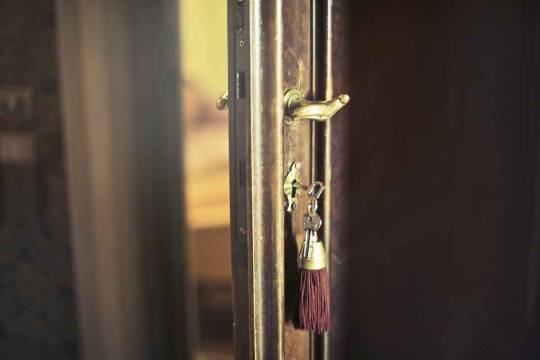
View On WordPress
#bluebeard#bluebeard retelling#bluebeard stories#diverse books#fantasy#Gothic Fiction#gothic horror#Horror#horror books#mr fox#queer fairytales#queer gothic fiction#queer horror#queer retellings#robber bridegroom#sff#strange suitor
1 note
·
View note
Text
if you make a period drama or fairytale retelling with queer or trans characters but nothing especially 21st-century about it
and then call it "updated" or "modernized"
you owe every LGBT person $500
#lgbt#gay#queer#period drama#fairytale#queer history#we are not inherently modern!!!! we have always been here!!!!#you are contributing to the attitude that queer/trans people are A New Thing!!!!
561 notes
·
View notes
Text
Sapphic/Lesbian Fairytale Retelling Recommendations?
I've been on a fairytale/folklore retelling with a sapphic twist kick lately (mostly because I've been brainstorming a loose one for an OG project) and I was wondering if my dear and illustrious followers (and those who come across this post) may have recommendations they want to shout out.
So far, I've read:
Malice by Heather Walter (Sleeping Beauty),
Bitterthorn by Kat Dunn (Beauty and the Beast with some Sleeping Beauty),
The Dark Wife by Sarah Diemer (Persephone and Hades)
(those are the ones I can remember reading as of late)
I have The Misadventures of an Amateur Naturalist by Ceinwen Langley and Thorn by Anna Burke coming in the mail soon.
I definitely know there is more to read, but idk where to even start. Let me know if you guys have any suggestions!
Thanks! Stay safe and happy!
#lucidmagic reads books#book recs#book recommendations#lesbian books#sapphic books#fairytale retelling#sapphic book recs#lesbian book recs#queer books#lgbt books#sapphic romance#sapphic fairytale retellings
67 notes
·
View notes
Text

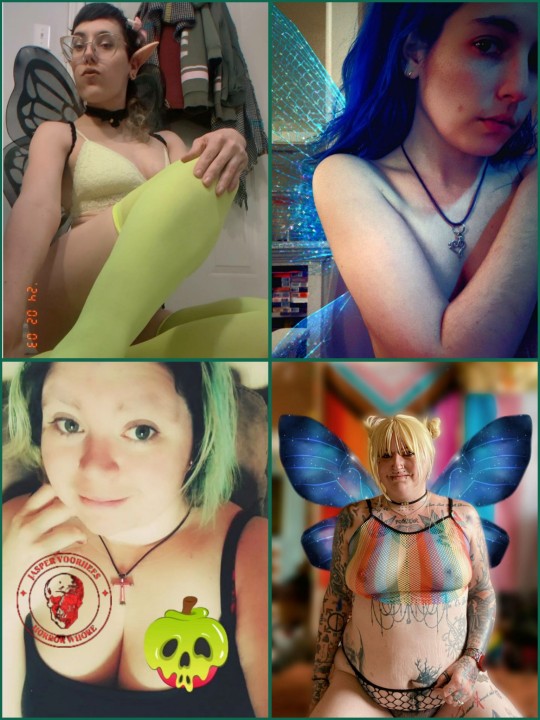
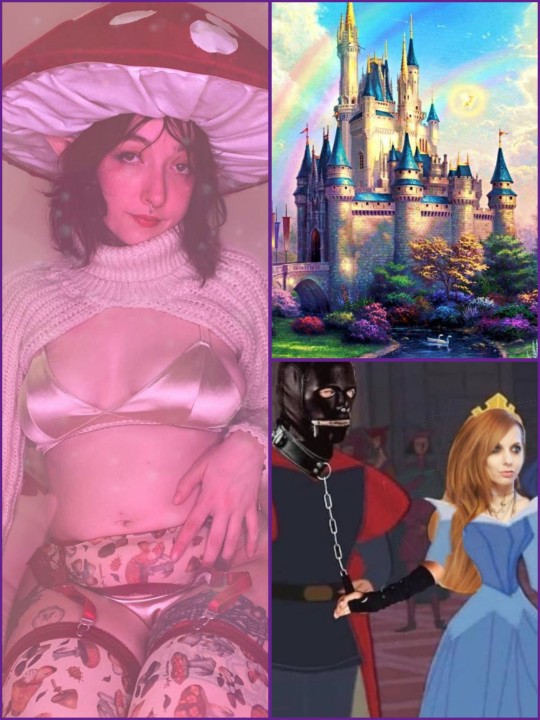
"In my thoughts and in my dreams
They're always in my mind
These songs of hobbits, dwarves and men
And elves
Come close your eyes
You can see them, too"
🏰🧚♀️👑🦄💫🏰🧚♀️👑🦄💫🏰🧚♀️👑🦄💫🏰🧚♀️👑🦄💫
some of your favorite sex workers came together for a v magical fairy tale day 💕 they were showered with gifts of love, praise & tippies from citizens of tumblrland...and they all lived happily ever after 🌈
@godshideouscreation • @kissesfromkenz • @weedstop • @mrsbigbootyminx • @blueberryheartache • @jaspervoorhees3 • @frankieglam • @thelusciouslibra • @burythecarnival
🏰🧚♀️👑🦄💫🏰🧚♀️👑🦄💫🏰🧚♀️👑🦄💫🏰🧚♀️👑🦄💫

#my tumblr family#fairytale day ✨#lgbtqia#collab#my favorites 💜#ridiculously attractive people#support content creators#support sex workers#queer#nonbinary#gay#the bard's song#blind guardian
49 notes
·
View notes
Text
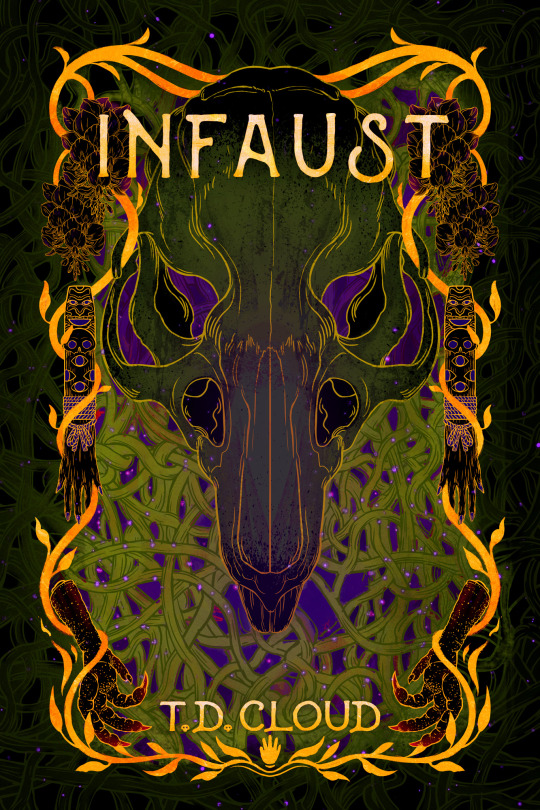
Happy Infaust cover reveal Friday! Give it up for @ambisun for another banger of a cover! But of course, this is only the beginning...
A witch with a dead familiar is an outlier and an ill-omen to every village they pass through. Rehan Nadir is one such witch. The only jobs available to him are terrible ones, and vagrancy is his only recourse… At least, it was until he heard tell of the town of Hamelin’s plight. Stories of a malicious entity, a chaos god, have tormented the village for hundreds of years, and like clockwork tragedy has struck once more: while the adults gathered elsewhere, the children were spirited away. No trace of them has been seen since. The town is desperate to bring them back. Very desperate.
Finding and returning the lost children would be just the thing to give Rehan a new chance at the life he lost after the death of his familiar, and if all it takes is killing a god of chaos, then he’s more than ready to take the plunge and open that door. Unfortunately, he just didn’t anticipate opening a few more in the midst of dealing the finishing blow.
More Info below!
Infaust is a dark romance recounting the tale of the witch Rehan Nadir and the elusive chaos god known only as the Piper. Trapped in a world where even the very dirt wants them dead, the two must depend on one another to escape—and along the way realize that perhaps the definition of a happily ever after really is a subjective one.
This is a story for those of us who know things can always get worse, that there's always still something left to lose. Infaust has been a very long time coming, starting as an initial concept idea back in 2018 and undergoing multiple rewrites over the years to bring it to the state it's in now. But with that long timeline comes bigger pay-offs. I'm incredibly proud of where this story has gone and all that it continues to develop into.
With that said...
This isn't the final cover.
I've had to delay this reveal once already, and nearly did so again last night. My cover artist is currently in the midst of an international move and her time is, as you can well imagine, limited. We thought we'd have the final cover done last night but alas, we had to prioritize elements to meet this deadline. The actual cover will look a little closer to this when it's all said and done.
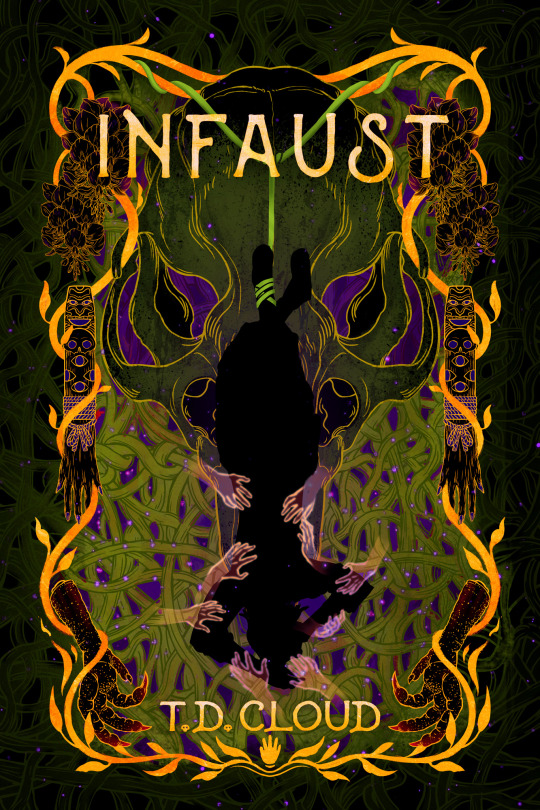
I don't have a solid date yet on when to expect this full version alongside the full spread. Our tenuous goal is April 10th, but moving to a different country isn't easy, simple, or fun. We'll have it by the time the book launches, so please be patient with us as we navigate this really bumpy timeline!
If you'd like to pre-order Infaust, you have a few options!
For Signed Paperback copies alongside a really cool, limited-run merch box bundle, please check out my Itchio: https://tdcloud.itch.io/infaust
For unsigned pre-orders, the Amazon sales page is the place to go for ebooks, with paperbacks coming closer to the launch date: https://amazon.com/dp/B0CRX5M7TX
Thank you so much for your support thus far and your excitement for Rehan's terrible, no-good dance with the Devil. It means the world, and I'm so excited to unleash this beast May 1st!
#infaust#cover reveal#indie author#folklore#fairytale#dark fairytale#dark romance#horror#queer#queer horror#update
34 notes
·
View notes
Text

#st-jinx-art#fairy#fairytale#fairy tale#spooky#spooky season#gay artists#gay fantasy art#gay art#gayart#gay fantasy#newblvotg#gay#queer#art#magic#the magicians#warlock#warlocks#fairy land
87 notes
·
View notes
Photo


Just found out about the existence of these two books. Haven’t read them, and probably won’t in the immediate future, but I think it is worth pointing out they exist for those that might access them.
First is “Transgressive tales: Queering the Grimms”, a series of essays about studying the fairytale of the Brothers Grimm from a queer point of view - exploring the tales that can be read as homo-erotic or explaining how certain characters break down the gender norms.
Second is “Queer Enchantments: Gender, Sexuality and Class in the fairy-tale cinema of Jacques Demy”. As the title says it is an exploration of the movies of Jacques Demy - and how they play, deconstruct, reinvent or explore the themes of queerness, class, sexuality, genders, etc etc... If you follow this blog since last year you will recognize the name of Jacques Demy - he is the French movie-maker that created the “Donkey Skin” movie I made a series of posts about. (And which is the most famous movie adaptation of this fairytale to this day).
Now, it might seem that this book only focuses on his two fairytale movies, onkey Skin and The Pied Piper of Hamelin - but in truth it also explores the other movies of Demy by decoding their fairytale ambiance, themes and connotations. It notably focuses on “Lola” and “The Umbrellas of Cherbourg”, placed in parallel with “Cinderella” and “Sleeping Beauty”.
#book#book reference#queerness in fairytales#queer fairytales#grimm fairytales#jacques demy#gender in fairytales#fairytale movie#french movie#fairy tales#fairytales
7 notes
·
View notes
Text
Do you love fairy tales? I want to hear from you!
EDIT: I will be closing the survey on November 9th! Thank you everyone who has participated!!!
My name is Ainjel Stephens and I am a PhD candidate in the Folklore department at Memorial University of Newfoundland. I am currently conducting a research project on fairy tales reception by queer-identifying individuals for my PhD dissertation under the supervision of Sarah Gordon. The purpose of this study is to learn how people who feel queer or identify as queer think about and respond to fairy tales.

Artist: Gustave Dore
If this sounds like a project you would be interested in participating in, then I invite you to take a short survey where you will be asked a few questions about who you are, as well as reflective questions about your thoughts and feelings on fairy tales, and if these tales are “queer.” It should only take about 10 minutes of your time to complete.
The survey asks if you would like to participate further with an interview with myself in order to discuss your thoughts and opinions on fairy tales. This interview will be a recorded hour-long interview through video conferencing platform Tauria or Webex. If you select yes, I will be in contact with you with further steps. If you select no, then that’s it! Thank you for participating.
To participate, you must be the age of majority and no younger than 19, have fairy tale knowledge in English, and identify with the term “queer.”
If you are interested, click the link below to participate in the anonymous survey.
If you have questions or want to chat further, you can contact me at [email protected] or through my inbox on my project blog, www.diamondsandtoads.tumblr.com/
If you know anyone who may be interested in participating in this study, please send this post along.
Thank you for reading!
The proposal for this research has been reviewed by the Interdisciplinary Committee on Ethics in Human Research and found to be in compliance with Memorial University’s ethics policy. If you have ethical concerns about the research, such as your rights as a participant, you may contact the Chairperson of the ICEHR at [email protected] or by telephone at 709-864-2861
#fairytales#fairy tale retelling#queer#lgbt#lgbtq community#beauty and the beast#cinderella#little red riding hood#charles perrault#grimms#grimm fairy tales#queer fairy tale#diamonds and toads#folklore#folktale#snow white#sleeping beauty#queer writers#queer community#lgbt community#the princesses#academia#queer fairytales
258 notes
·
View notes
Text








The Seal and the Ravens
OC INTRODUCTION - Isold

Isold is the fourth born of the Diams, cast out with her brothers at only six years old, burdened by a name and role she hasn't yet realised are not her own. She finds solace with the fae, who embrace her and raise her to be who she is.
Isold is not a POV character in the book, Jeric is the only one of Astra's siblings who is - but I'm looking forward to writing about her, I think the conflict she and Astra have will be pretty interesting!
See more about The Seal and the Ravens here!
Leave a comment or send an ask to be added to the taglist.
#writeblr#writers of tumblr#fairytale retelling#fantasy fiction#fairytale crossover#queer ocs#trans ocs#my wips#my ocs#my writing#wip: seal and ravens#oc: isold
22 notes
·
View notes
Text
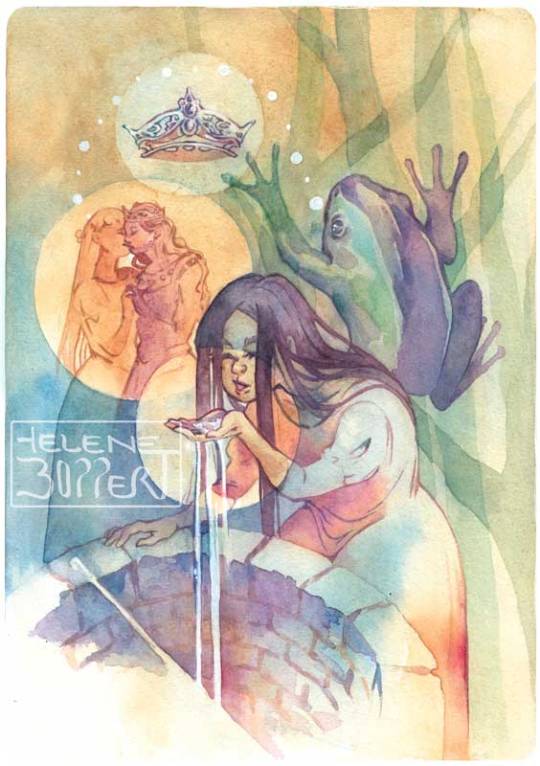
Illustration for Wain, written by Rachel Plummer and published by TheEmmaPress
Scottish folklore poems with an all lgbtq cast 🏳️🌈
If you want to find out which scottish folklore character this is... go on to read the book!
#artists on tumblr#my art#watercolor#illustration#lgbtq#diversity#gay#queer#lesbians#fairytale#folklore#mythology#working artist#stories#story illustration
54 notes
·
View notes
Text

♡ 'Wonderling' ♡
HB pencil; coloured pencils; Sakura Gelly Roll glitter pens (silver & gold); 2023.
Original drawing available here.
#art#drawing#artists on tumblr#illustration#kawaii#cute#fairycore#dreamy#pastel aesthetic#deer#fawn#fairytale#fairy kei#rainbow#magical#butterfly#artists#female artists#queer artists#cute art#kawaii art#cute aesthetic#kawaii aesthetic#etsy
341 notes
·
View notes
Text
fuck it, let’s die on this hill
FAIRYTALE OF NEW YORK IS THE ULTIMATE QUEER YULETIDE SONG
the straights have been getting increasingly uncomfortable with it in the last few years. you’re going to see a big resurgence of the censored version this year because Shane MacGowan died last week, but it has been well on the decline - meaning a wide open gulf is forming to allow the cheap, lousy faggots to swoop in and continue colonising it. here’s why we should
firstly it’s an absolute banger. traditional irish music combined with modern drums into a sound that fits the yule aesthetic perfectly whilst bringing drama and emotion. it’s cozied up by the fire, but alive and dramatic
the biggest source of discomfort for most people is that it’s MacGowan and MacColl aggressively arguing at each other, rattling off textbook sexist vitriol. and MacColl calls MacGowan a faggot, with total sincere usage of the slur, hatred and all. putting the slur aside, the nastiness of the song gets people’s ire. it’s a couple having a stereotypical domestic and they seem to kiss and make up in the final act, all unacceptable behaviour forgiven. it’s everything modern straights want to put in the past. so let them. it’s a het couple being toxic, cool. queer celebration has attached the bandwagon to worse things and it’s always taking up the castoffs of heteronormative society. queer love can be made of FONY all the same:
MacGowan’s first verse stings, does it not? sadness, desperation, and longing. in queer society, we have all been MacGowan’s character and we have all been the Old Man, even if it’s not the bottle and the drunk tank. we’re survivors, we’re bloodied and bruised, we refuse to go away no matter how many AIDS-genocides, moral panics, and hate-murders they do to us. there are nights where we think by all mercy we Won’t See Another One, and we turn our face away and Dream About You. there’s always hope. there’s always reasons to continue the fight, and they don’t have to be abstract
when the sobbing’s over, the Pogues immediately come to life for the main body. we go up and down the rollercoaster of emotions while the band keeps playing, while the air is always jubilant. the wonder, the delight, the hope, the madlove, the melodrama, the bile, the hatred. for a song making allusions of broadway, it sounds fresh from broadway - our story is painted through feelings, not words. and when it’s over, MacColl’s character (seems to, judging by the tonal finality of MacGowan’s lines and her participation in the final chorus) forgives her abusive partner and reattaches her hopes to him, her drunkard patriarch. but we’re queer, remember - we’re not celebrating these straggot pieces of shit. we find identity in the feelings. we have all been MacColl’s character, finding wonder and hope and the chance to become who we want to be, and being given false promises by false starts. and if you’ll forgive me for entertaining MacGowan’s character’s bastard misogynist perspective for a second, we’ve all found ourselves having to defend our queer communities, having to stand by our old sluts on junk, even as doing so takes its toll and sometimes feels like a burden. those feelings happen. they are irrational, they are bad, and they happen. and a new day comes and we’re thankful we stood by. it’s a melodramatic broadway banger - we can find meaning in all places, even the ‘b*tch-wife’ slurrings of a misogynist
it’s that power that lets a queer reading of FONY stick the fucking landing. again i repeat myself, from a surface reading the ending is toxic as shit. but queer reading is in the feeling. this lament, this mournful lament, of misplaced hopes, of lost dreams, and a commitment to what we have, and looking forward despite unbearable challenge. you’d scream ‘leave him!’ to every straight MacColl in the world, that’s like, feminism 101 - but queer life is nothing if not complicated. the queer-read MacGowan isn’t a toxic gay lover. he is queer life itself. he took our dreams from us when we first found him, so it may appear. the hatred we feel inside, the emptiness, the pain, it’s all there with the phantasmic joy, the discovery, the love, the everything. and the band always keeps playing. straight MacColls returning to their straight MacGowans is stupid, but we don’t have a choice. our community is everything, our support is everything. it’s rough. it can almost kill you. but would any of us trade it for anything else? we are MacColls and MacGowans all at once - we are the ones with fragile hopes, we are the ones who damage it, and shepherd it still. we’re our own worst enemy and we’re all we have
when Shane MacGowan adapted the original lyrics of a lonely seafarer, he did not turn it into a queer song. in fact, he wrote a character yelling the f-slur. there is not a gramme of queercoding here. but exactly what is the difference between the actual faggots finding commonality in the villain songs penned to mock us, or old broadway songs that have nothing to do with us, and the yuletide song that actively hates us? fucking little, i would argue. queer celebration’s power is its ability to reconstrue. they call us faggot every month of the year with nary a second thought, and we spit it right back at them with reclamation and solidarity. we should do the same in december. we dance to the tune of their bigotry and we sing along at the top of our lungs. they are quietening down out of embarrassment - long may our party reign. FONY, a bigoted song, is a queer anthem because it has been made so. the madness. the love. the sadness. the dreams. that is queerness. and queer revolution is not giving one single, solitary shite about straight people’s discomfort about what the cheap, lousy faggots choose to celebrate. the way the ending instrumental tapers off into beautiful emotion - the straights have abandoned it: that feeling of love, that feeling of joy, that feeling belongs to us now
sing it like you would all queer songs. hold your friends close and celebrate them. love everyone around you. and when the naughty word comes around, scream it
#196#fairytale of new york#the pogues#shane macgowan#christmas music#rule#apartmentofawesome#fagposting#lgbtq#queer
36 notes
·
View notes